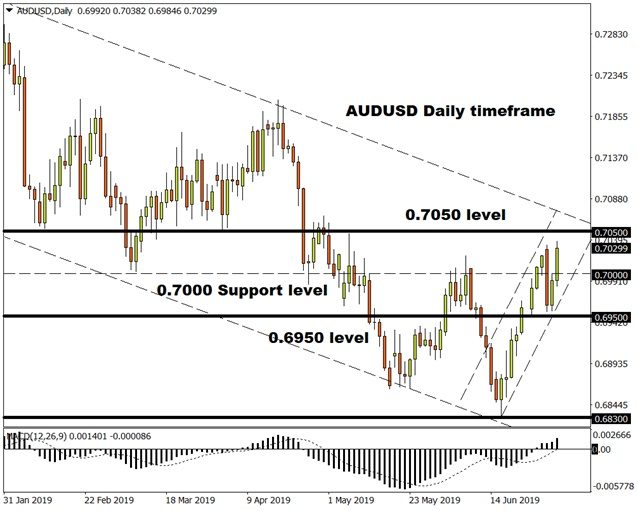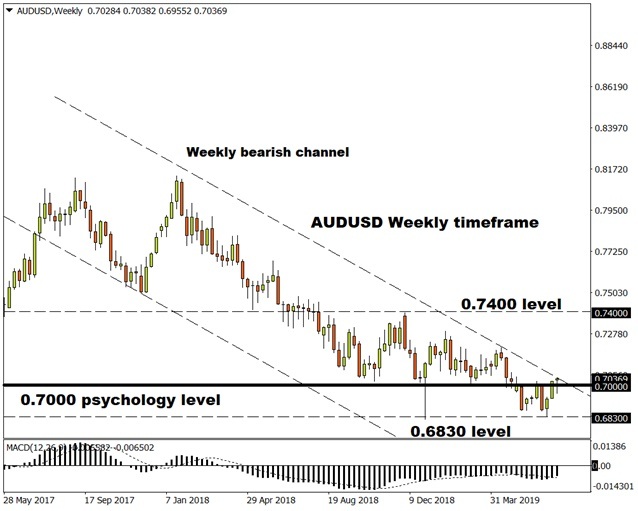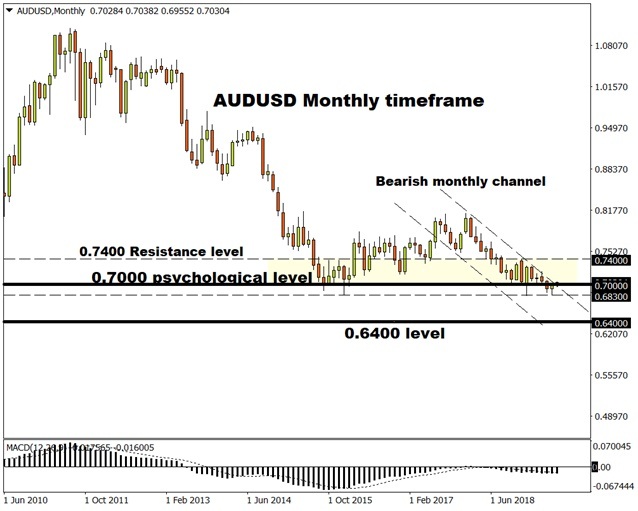The Australian Dollar’s bearish trend that began in early 2018 is set to extend into the current quarter.
The Reserve Bank of Australia has come a long way from earlier in the year when it painted a picture of steady growth for the domestic economy. The central bank then proceeded to lower its cash rate target by 25 basis points in June, beforecutting rates by a similar margin again at the start of July. As worries increase about weakereconomic conditions, Australia’s benchmark interest ratehas reached a new record low of one percent. Those cuts were heavily anticipated by investors, sending the Aussie down over one percent against the greenback in Q2, erasing gains from the first quarter to register an overall decline of 0.4 percent for the first half of 2019.
Fed rate cut could offer limited relief for AUD
Later this month, it could be the Federal Reserve’s turn. Investors will turn their attention to the scheduled FOMC meeting at the end of July to see if Fed chair Jerome Powell and hiscolleaguesjoin the easing party. At the time of writing, Fed Funds futures point to a 100 percent chance of a US rate cut this month.Although a Fed rate cut has been largely priced in, the actual event could still offer some limited relief forthe Australian Dollar and nudge ittowards the 0.7 mark against its US counterpart.
US-China tensions to continue holding sway over AUD performance
Another theme that’ll continue to drive the Australian Dollar’s performance is US-China trade tensions, given that Australia’s dependence on the Chinese economy is the highest compared to other developed nations. According to the Australian Department of Foreign Affairs and Trade, China accounted for 34 percent of Australia’s total goods exports in 2018.
Yetthe recently announced truce between US President Donald Trump and Chinese President Xi Jinping wasn’t enough for the AUDUSD to break above its 100-day moving-average of 0.7035. Revived US-China trade talks merely delay the risk of more tariffs being imposed, without completely nullifying the threat. Keep in mindthe tariffs that have already been implementedon US-China trade remain in place. The heightened tensions are clearlydampening global growth. For proof, look no further than Asia’s exports slump, Europe’s sluggish manufacturing sector and declining PMI figures around the world. Given Australia’s outward-facing economy,AUD’s appeal has been muted.
Australia’s uninspiring economic outlook to weigh on AUD
Australia is certainly not immue to the downside external risks, with exports and investments having been curtailed by concerns over global trade tensions. First quarter GDP of 1.8 percent was its lowest since 2009, while inflation has stubbornly failed to live up to the RBA’s target range of 2-3 percent. Falling house prices have dampened consumer sentiment,and Australia’s unemployment rate remains above five percent.
The gloomy economic indicators only serve to dampen sentiment surrounding AUD, until at least the fiscal stimulus cavalry comes to the aid of the domestic economy, while the lowered cash rate finds its way into consumers’ pockets. The prospects of more government spending, coupled with potential gains in commodity prices, could offer underlying support for the Australian Dollar in the third quarter. However, whether AUD can take advantage of such tailwinds is contingent on the global demand outlook not deteriorating any further due to a rapid escalation in US-China trade tensions.
AUDUSD bearish trend to remain intact in Q3
From a technical perspective, the currency pair’s moving averages have acted as stubborn resistance levels, leaving AUDUSD with a path-of-least-resistance to the downside. Hence, the Australian Dollar is expected to remain below the 0.7 psychological level for most of Q3.
Disclaimer:This written/visual material is comprised of personal opinions and ideas. The content should not be construed as containing any type of investment advice and/or a solicitation for any transactions. It does not imply an obligation to purchase investment services, nor does it guarantee or predict future performance. FXTM, its affiliates, agents, directors, officers or employees do not guarantee the accuracy, validity, timeliness or completeness of any information or data made available and assume no liability for any loss arising from any investment based on the same.
Risk Warning: CFDs are complex instruments and come with a high risk of losing money rapidly due to leverage. 90% of retail investor accounts lose money when trading CFDs with this provider. You should consider whether you understand how CFDs work and whether you can afford to take the high risk of losing your money.
Recommended Content
Editors’ Picks
USD/JPY jumps above 156.00 on BoJ's steady policy

USD/JPY has come under intense buying pressure, surging past 156.00 after the Bank of Japan kept the key rate unchanged but tweaked its policy statement. The BoJ maintained its fiscal year 2024 and 2025 core inflation forecasts, disappointing the Japanese Yen buyers.
AUD/USD consolidates gains above 0.6500 after Australian PPI data

AUD/USD is consolidating gains above 0.6500 in Asian trading on Friday. The pair capitalizes on an annual increase in Australian PPI data. Meanwhile, a softer US Dollar and improving market mood also underpin the Aussie ahead of the US PCE inflation data.
Gold price flatlines as traders look to US PCE Price Index for some meaningful impetus

Gold price lacks any firm intraday direction and is influenced by a combination of diverging forces. The weaker US GDP print and a rise in US inflation benefit the metal amid subdued USD demand. Hawkish Fed expectations cap the upside as traders await the release of the US PCE Price Index.
Stripe looks to bring back crypto payments as stablecoin market cap hits all-time high

Stripe announced on Thursday that it would add support for USDC stablecoin, as the stablecoin market exploded in March, according to reports by Cryptocompare.
US economy: Slower growth with stronger inflation

The US Dollar strengthened, and stocks fell after statistical data from the US. The focus was on the preliminary estimate of GDP for the first quarter. Annualised quarterly growth came in at just 1.6%, down from the 2.5% and 3.4% previously forecast.


